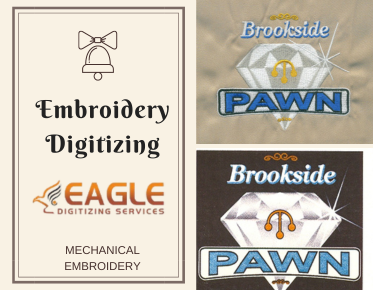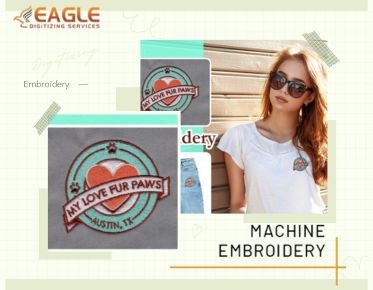3D Embroidery Digitizing Explained: What Is It?
3D embroidery digitizing is revolutionizing the world of textile design. Transforming flat designs into raised, textured artworks, adds depth and dimension to embroidery, making designs literally pop. This advanced technique is increasingly popular in fashion, home décor, and personalized items, offering a new level of sophistication and creativity.
Understanding 3D Embroidery: The Basics
At its core, 3D embroidery involves creating designs that stand out from the fabric surface, using specialized stitches and materials. Unlike traditional embroidery, which lies flat, 3D embroidery uses techniques like foam underlay to elevate the threads, producing a tactile, raised effect that enhances the visual appeal.
Why 3D Embroidery is Gaining Popularity
The allure of 3D embroidery lies in its ability to add a luxurious, eye-catching element to various items. As consumers seek unique, personalized products, the demand for 3D embroidered items has skyrocketed. From bespoke clothing to custom home accessories, this technique provides a premium, bespoke feel that sets products apart.
The History and Evolution of 3D Embroidery
3D embroidery has its roots in traditional embroidery but has evolved significantly with advancements in technology. Initially, achieving a raised effect was labor-intensive and time-consuming. However, with the advent of modern embroidery machines and digitizing software, creating intricate 3D designs has become more accessible and efficient.
How 3D Embroidery Digitizing Works
The Science Behind 3D Embroidery
The science of 3D embroidery lies in the interplay between stitch types, thread tension, and materials. By layering stitches over foam or other padding materials, the design gains height and dimension. The precision of the digitizing process ensures that the raised elements are uniform and aesthetically pleasing.
From Flat to Fabulous: The 3D Embroidery Process
The process starts with a digital design, which is then converted into a format that an embroidery machine can read. Specialized software is used to plot the stitches, taking into account the desired height and texture. Foam or other materials are placed under the fabric, and the machine meticulously stitches over them, bringing the design to life.
Tools and Software for 3D Embroidery Digitizing
Essential Software for 3D Embroidery
Several software options cater to 3D embroidery digitizing, each offering unique features for creating complex designs. Programs like Wilcom, Hatch, and Brother's PE-Design allow designers to manipulate stitch density, direction, and layering to achieve the desired 3D effect. These tools are essential for converting 2D designs into stunning 3D masterpieces.
Hardware You Need for 3D Embroidery Digitizing
In addition to software, quality hardware is crucial for 3D embroidery. A robust embroidery machine capable of handling dense stitching and foam underlay is essential. High-resolution scanners and graphic tablets can also aid in refining designs before digitizing, ensuring precision and clarity.
Designing for 3D Embroidery
Creating the Perfect 3D Design: Tips and Tricks
Designing for 3D embroidery requires a keen eye for detail and a good understanding of how stitches interact with different materials. Begin with simple designs and progressively add more complicated aspects. Use bold lines and contrasting colors to enhance the 3D effect, and always test your design on a sample fabric before full production.
Choosing the Right Elements for 3D Effects
Selecting the right elements is key to achieving a striking 3D effect. Elements like letters, logos, and simple shapes work well in 3D. Consider the overall composition and ensure that the raised elements do not overwhelm the design. Balance is crucial to maintaining visual appeal.
Stitch Types and Techniques
Exploring Different Stitch Types for 3D Embroidery
Various stitch types can be used to create 3D effects, including satin stitches, fill stitches, and running stitches. Satin stitches are particularly effective for creating raised elements due to their thickness and shine. Experimenting with different stitch types can add variety and texture to your designs.
Mastering Techniques for Depth and Dimension
Mastering techniques like foam underlay, cording, and layering is essential for adding depth and dimension. Foam underlay involves placing foam beneath the fabric and stitching over it, while cording uses thicker threads to create a raised effect. Layering stitches of different lengths and directions can also enhance the 3D look.
Materials and Threads for 3D Embroidery
Selecting the Best Materials for 3D Embroidery
Choosing the right materials is crucial for 3D embroidery. High-quality, dense fabrics like twill and canvas provide a sturdy base for raised designs. Foam sheets in various thicknesses can be used to achieve different heights, while specialty threads add texture and sheen.
Thread Choices: What Works Best for 3D Effects
Threads play a significant role in the final appearance of 3D embroidery. Polyester and rayon threads are popular choices due to their strength and vibrant colors. Metallic threads can add a touch of elegance and shine, making the 3D elements stand out even more.
Common Challenges and How to Overcome Them
Avoiding Common Pitfalls in 3D Embroidery Digitizing
Common pitfalls in 3D embroidery include puckering fabric, uneven stitching, and thread breaks. To avoid these issues, ensure proper tension settings on your machine and use high-quality stabilizers. Regular maintenance of your embroidery machine also helps prevent technical problems.
Troubleshooting Tips for 3D Embroidery Projects
When troubleshooting, check for consistent thread tension and ensure that the foam underlay is securely in place. If stitches are uneven, adjust the stitch density or change the needle size. Always run a test design to identify and resolve issues before starting on the final piece.
Applications of 3D Embroidery
Fashion and Apparel
High Fashion: 3D Embroidery on the Runway
In the world of haute couture, 3D embroidery is making waves. Designers are incorporating raised patterns into their collections, adding a tactile element to high fashion pieces. Dresses, blouses, and jackets adorned with 3D embroidered elements catch the eye and add a touch of luxury, making them stand out on the runway.
Everyday Wear: Adding Flair to Casual Clothing
3D embroidery isn’t just for high fashion; it’s also a fantastic way to add a unique touch to everyday wear. T-shirts, jeans, and even sweatshirts can be elevated with creative, textured designs. Whether it’s a floral motif or an abstract pattern, 3D embroidery brings an element of fun and individuality to casual attire.
Personalized Clothing: Custom 3D Embroidery
Personalization is a significant trend in fashion, and 3D embroidery is perfect for creating custom pieces. Monograms, names, and bespoke designs can be embroidered onto clothing, making each item unique. This is particularly popular for gifts, allowing for a personal touch that shows thought and care.
Home Decor
Revamping Upholstery with 3D Embroidery
Furniture upholstery can be transformed with 3D embroidery. Chairs, sofas, and headboards adorned with raised patterns add a touch of elegance and sophistication to any room. This technique allows for endless customization, making it easy to match your decor style.
Creative Cushion Covers: Standout Designs
Cushion covers are a popular canvas for 3D embroidery. These small, versatile items are perfect for experimenting with different designs and textures. Whether you prefer bold, geometric patterns or delicate florals, 3D embroidery can make your cushions true statement pieces.
Wall Art and Tapestries: Bringing Walls to Life
Wall art and tapestries offer another fantastic application for 3D embroidery. By combining traditional embroidery techniques with raised elements, these pieces can create stunning visual effects that add depth and interest to your walls. Custom 3D embroidered art pieces can become focal points in your home, showcasing your style and creativity.
Accessories
Handbags and Purses: Unique Textured Designs
Handbags and purses are perfect canvases for 3D embroidery. Adding raised designs to these accessories makes them stand out, turning everyday items into unique fashion statements. From subtle embellishments to bold, intricate patterns, 3D embroidery can transform a simple bag into a work of art.
Shoes: Stepping Up with 3D Embroidery
Shoes with 3D embroidery are making a mark in the fashion world. This technique can be used to add intricate designs to sneakers, boots, and even high heels, creating footwear that’s both stylish and unique. The added texture and dimension give shoes a distinctive edge, perfect for those looking to make a statement.
Hats and Caps: Topping Off with Style
Hats and caps are another great application for 3D embroidery. Whether it’s a custom logo, a name, or an intricate design, adding raised embroidery to headwear makes it stand out. This is a popular choice for promotional items, team gear, and personalized gifts, offering both style and individuality.
Corporate and Promotional Uses
Company Logos: Making Brands Stand Out
In the corporate world, 3D embroidery is an excellent way to make company logos pop. Whether on uniforms, promotional items, or corporate gifts, raised embroidery adds a touch of professionalism and quality. This technique ensures that logos are not only seen but felt, making a lasting impression.
Custom Uniforms: Adding Professional Touches
Uniforms with 3D embroidery add a professional touch that sets businesses apart. From hotel staff to retail employees, custom embroidered uniforms enhance brand identity and create a polished, cohesive look. The added texture and detail convey a sense of quality and attention to detail.
Promotional Items: Creating Memorable Giveaways
Promotional items with 3D embroidery are memorable and impactful. Whether it’s caps, bags, or apparel, the added dimension makes these items stand out. This technique ensures that promotional products are not only useful but also visually appealing, increasing their value and effectiveness as marketing tools.
Events and Celebrations
Wedding Attire: Elegant and Personalized Touches
3D embroidery adds an elegant and personalized touch to wedding attire. Brides can have their gowns adorned with intricate raised patterns, while grooms can add custom designs to their suits. This technique also works beautifully on veils, handkerchiefs, and other wedding accessories, making the big day even more special.
Birthday and Anniversary Gifts: Custom Keepsakes
Custom 3D embroidered gifts are perfect for birthdays and anniversaries. From personalized towels and robes to unique clothing and accessories, these items make thoughtful and memorable presents. The added texture and detail show extra care and effort, making the gifts truly special.
Holiday Decorations: Festive and Fun Designs
Holiday decorations with 3D embroidery bring festive cheer to any home. From Christmas stockings and tree skirts to Easter banners and Halloween decorations, raised embroidery adds a playful and unique touch. These items can be customized with names, dates, and designs, creating one-of-a-kind holiday decor.
Quality Control in 3D Embroidery Digitizing
Ensuring Top-Notch Quality in Your 3D Designs
Quality control is paramount in 3D embroidery. Inspect each design for uniformity in height, stitch density, and overall appearance. Using high-quality materials and regularly calibrating your equipment ensures consistent, professional results.
Final Checks and Balances Before Production
Before full-scale production, conduct thorough checks on sample pieces. Look for any flaws in the stitching or material and make necessary adjustments. This step is crucial to ensure that the final product meets the highest standards of quality and durability.
Starting your journey into 3D embroidery digitizing involves investing in the right tools, learning the techniques, and practicing regularly. Begin with simple designs and gradually tackle more complex projects as you gain confidence and skill.
Plenty of resources are available for aspiring 3D embroiderers, including online tutorials, forums, and workshops. Follow industry experts and join embroidery communities to stay inspired and informed. With dedication and creativity, the possibilities in 3D embroidery are limitless.



